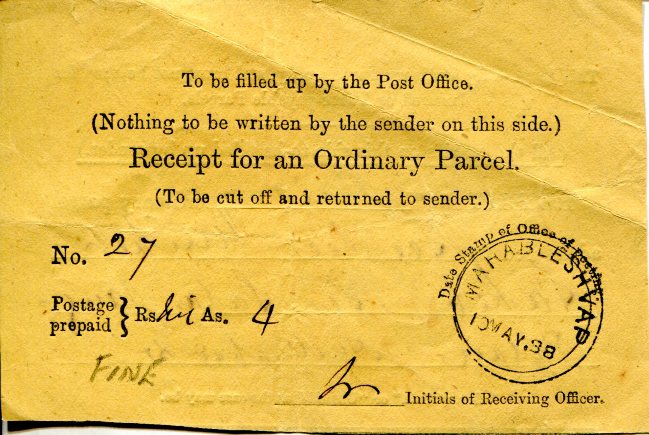Indian Parcel Receipt

Preamble
The aim of this brief account of Postal Receipts, Acknowledgements and Lables is to enable collectors to understand and identify such of them as pass through the Post and become the property of receivers or are given to the customers as a part of postal transactions. I have selected only the commonly seen from and wherever possible given the departmental numbers assigned to them, which are sometimes printed on them.
Introduction
Receipt for the Sender of a Parcel
Prior to 1873, the sender of a Parcel was granted a receipt prepared and presented by him. From 1873, a printed receipt was issued by Post Office. In 1885 it formed part of the form which included the Parcel Receipt to be signed by the addressee. From 1888 it was issued from the Parcel Journal. It was abolished in 1899 as a receipt for a registered Parcel was then being issued from the Registered Journal. The Parcel Journal was used again for a short time in 1910.
From Numbers :
| Year |
Form No. |
Remarks |
| 1873 |
II1 |
|
| 1881 |
39 |
|
| 1882 |
39 |
revised |
| 1882 |
39 |
further revised |
| 1883 |
P-44 |
|
| 1885 |
P-9/P-7 |
|
| 1888 |
P-1 |
|
| 1897 |
P-1 |
revised |
| 1899 |
R-1 |
revised |
| 1901 |
R&P-1 |
|
| 1910 |
P-1 |
|
| 1912 |
R&P-1 |
|
| 1917 (?) |
R&P-1 |
revised |
Actual System
Indian Postal service has not only confined to its main task of delivering letters and being an effective mode of communication. It might appear surprising but the Post office was maintaining the dak (post) bunglows and sarais in those early days. For well over three decades from 1830s, the Post Office also facilitated road journey of the passengers. A traveller could book his seat in any palki, boat, horse, coach and cart carrying mails and parcels on payment to the post office a fixed amount in advance and take rest on wayside dak chowkee, later on known as dak bungalow.
| Click to Download |
| →Parcel Receipt Index |
| →Gallery |
|

